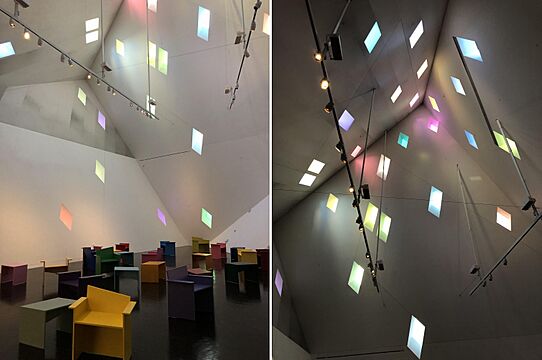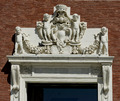Contemporary Jewish Museum facts for kids
 |
|
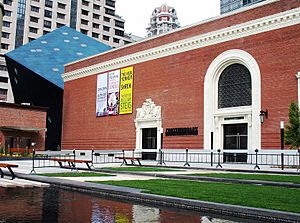
The former Jessie Street Substation (right) and the 2008 addition (left) designed by Daniel Libeskind.
|
|
| Established | 1984 |
|---|---|
| Location | 736 Mission Street, San Francisco, California, United States |
| Type | Art Museum |
| Public transit access | |
The Contemporary Jewish Museum (CJM) is a special place in San Francisco, California. It's located on Mission Street in the SoMa neighborhood. This museum started in 1984. It's built inside an old power station called the Jessie Street Substation. A famous architect named Daniel Libeskind redesigned the inside and added a new part. The new museum opened its doors in 2008.
The museum's main goal is to show how diverse and interesting the Jewish experience is for people today. It does this through cool exhibitions and fun educational programs.
Contents
What Happened in 2024?
In late 2024, the museum announced it would close for at least a year. This was because of money problems. It closed on December 15, 2024. Kerry King, the museum's director, said the closure was not meant to be forever. She explained that they needed time to rethink and rebuild. The CJM plays a special role in San Francisco, and they wanted to make sure it could continue.
Museum History
The Contemporary Jewish Museum began in 1984. For more than 20 years, it was in a small gallery near San Francisco's waterfront. By 1989, the museum realized more people wanted to join its programs. So, they decided to create a bigger, more central building. This new space would have more exhibitions, a dedicated area for learning, and places for live music, theater, dance, book events, and movies.
In the 2000s, there were talks about joining the CJM with another museum. This was the Judah L. Magnes Museum in Berkeley. However, they couldn't agree to combine the two museums.
Finally, in June 2008, the CJM opened its new, large building. It was 63,000 square feet in downtown San Francisco.
Exciting Exhibitions
The CJM is not a history museum, and it doesn't have a permanent collection of its own. Instead, it works with other museums to create and host many different exhibitions each year. The goal is to show how varied the Jewish experience is for people in the 21st century.
The museum does have one special art piece that stays there all the time. It's called Lamp of the Covenant by artist David Lane. This huge sculpture is 90 feet long and weighs 12,000 pounds! It's shaped like an arc and hangs above the museum's lobby. It's made from recycled steel, world globes, animal figures, Hebrew letters, and old-fashioned light bulbs. David Lane, who is not Jewish, says his artwork is about time, space, and the conversation between people and God.
Exhibitions at the CJM have explored many topics. They've looked at Jewish texts, holidays, and culture. They've also shown the role of Jewish people and artists in San Francisco and California. Many exhibitions highlight how Jewish artists, writers, photographers, filmmakers, designers, musicians, and business people have made a big impact on culture.
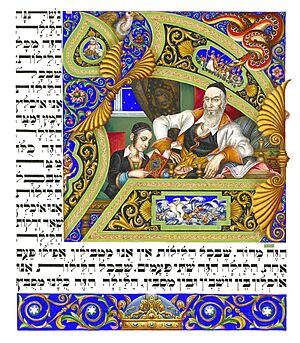

Some popular past exhibitions include:
- The Jim Henson Exhibition: Imagination Unlimited, 2022
- Experience Leonard Cohen, 2022
- Levi Strauss: A History of American Style, 2021
- Lew the Jew and His Circle: Origins of American Tattoo, 2019
- The Art of Rube Goldberg, 2018
- Roz Chast: Cartoon Memoirs, 2017
- Cary Leibowitz: Museum Show, 2017
- Stanley Kubrick: The Exhibition, 2016
- Bill Graham and the Rock & Roll Revolution, 2016
- Roman Vishniac Rediscovered, 2016
- Amy Winehouse: A Family Portrait, 2015
- Arnold Newman: Masterclass, 2015
- Project Mah Jongg, 2014
- Arthur Szyk and the Art of the Haggadah, 2014
- Beat Memories: The Photographs of Allen Ginsberg, 2013
- Kehinde Wiley, The World Stage: Israel, 2013
- Houdini: Art and Magic, 2012
- Black Sabbath: The Secret Musical History of Black-Jewish Relations, 2011
- There's a Mystery There: Sendak on Sendak, 2011
- Seeing Gertrude Stein: Five Stories, 2011
- Chagall and the Artists of the Russian Jewish Theater, 1919–1949, 2009
- From The New Yorker to Shrek: The Art of William Steig, 2009
Programs and Events
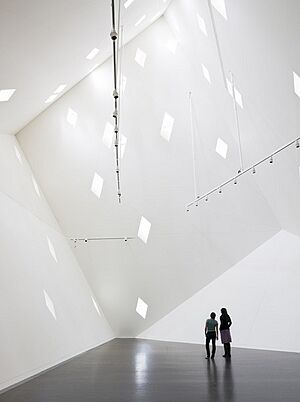
The museum offers many educational programs. These include public tours, classes, and workshops. They also show films, host talks, and have performances. The museum welcomes school visits and offers family art activities. There's even a special internship program for teens.
The Helen Diller Institute at the CJM is a place where experts and museum staff work together. They create exciting Jewish content and programs for everyone who visits. A key part of this institute is a Beit Midrash, which means "study hall" in Hebrew. This is where ongoing training happens to improve exhibitions and programs.
Unique Architecture
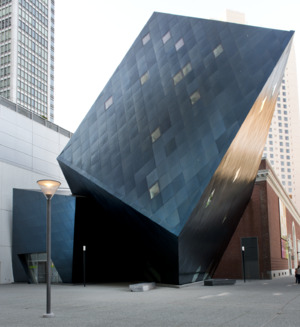
The museum's main building was once the Pacific Gas & Electric Jessie Street Substation. It was first built in 1881 and rebuilt in 1907 by Willis Polk after the big 1906 San Francisco earthquake. This historic building was added to the National Register of Historic Places in 1974.
Daniel Libeskind designed the new inside of the substation. He also added a new, tilted cube-shaped building. This new museum was finished in 2008 and cost $47.5 million.
The new part of the building is a dark-blue stainless steel cube. It looks like it slices into the old brick building. This design shows how the new and old parts connect. Libeskind's design kept important features of the old building, like its brick walls, trusses, and skylights. The top floor of the metal cube has 36 diamond-shaped windows. This area is called the "Yud" and is used for sound and performance exhibitions. Another part of the museum is a slanting rectangle called the "Chet." It holds the lobby, an education center, and part of an upstairs gallery.
Libeskind's design for the Contemporary Jewish Museum includes words, just like his Danish Jewish Museum in Copenhagen. He was inspired by the Hebrew phrase "L'chaim", which means "To Life." The Hebrew letters that spell "chai" — "chet" and "yud" — inspired the shape of the building. Libeskind explained that the "chet" creates a continuous flow for the exhibition and learning spaces. The "yud," with its 36 windows, is a special space for exhibitions, performances, and events. "To Life" is also a traditional Jewish toast. It refers to how the substation helped bring power back to the city after the 1906 earthquake. It also connects to the museum's goal of being a lively place for people to learn about Jewish culture. The Hebrew word pardes, meaning "orchard", is also part of the lobby wall.
How People Liked It
Critics generally liked the museum's design. Christopher Hawthorne from the Los Angeles Times said Libeskind found a good balance between exciting and calm shapes. He also liked that the galleries didn't have the architect's usual slanted walls. David D'Arcy from The Wall Street Journal also thought the museum was different from Libeskind's other work. He found a "lightness" to this museum that was rare for the architect. He felt it made the surrounding area, with its many glass and steel buildings, less boring.
Images for kids
Museum Leaders
Kerry King is currently the Executive Director of the museum. Before her, Chad Coerver (2021-2023), Lori Starr (2013–2020), and Constance Wolf (1999–2012) held the position. In 2018, Heidi Rabben was hired as the Senior Curator. Renny Pritikin was the Chief Curator from 2014 to 2018.
See also
- Magnes Collection of Jewish Art and Life in Berkeley, California
- The Jewish Museum, New York, NY
- Jewish Museum Berlin


